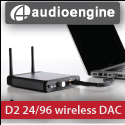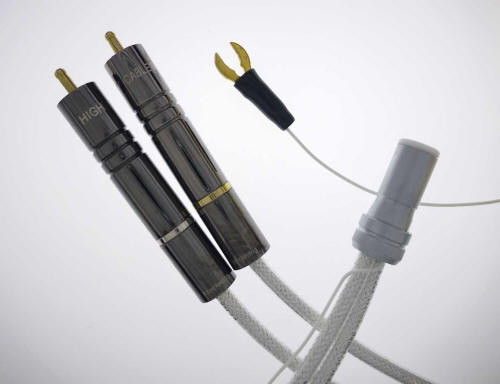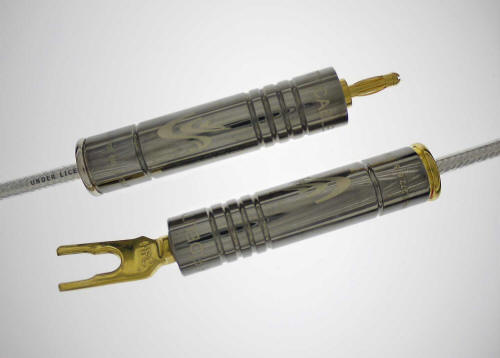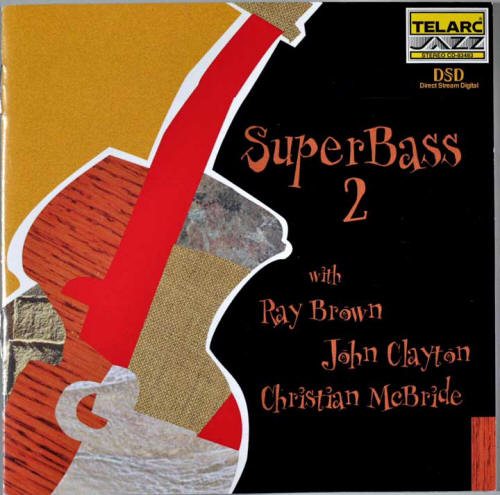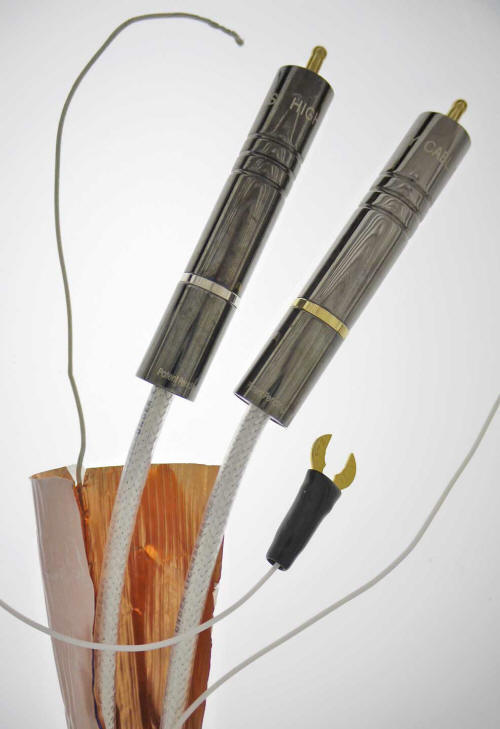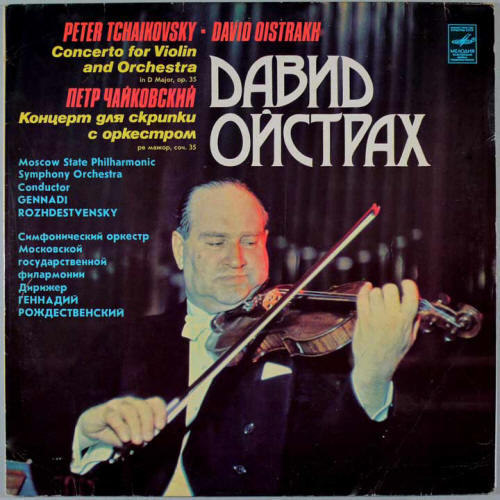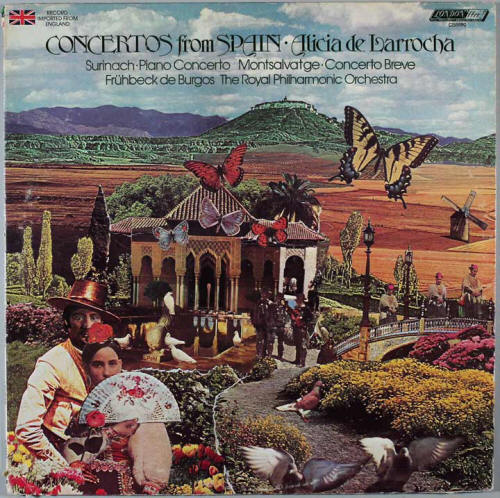|
|
You are reading the older HTML site
Positive Feedback ISSUE 68
high fidelity cables CT-1 Speaker and Enhanced Phono Cables as reviewed by Bruce Kinch
Back in Issue 65 I recounted my initial impressions of the High Fidelity Cables CT-1 Interconnects. In brief, Rick Schultz, previously known to many audiophiles as the man behind Virtual Dynamics cables, has devised and patented a unique method of managing electrical signal transfer he calls Magnetic Conduction. Without delving too deeply into the technology, it involves using magnets to maximize transmission through magnetically permeable conductors (presumably variants of mu metal) rather than the typical copper (and/or silver) used in 99.9% of conventional audio cables. Consequently, all the elements of the cabling—including connectors—have to be custom fabricated in small quantities rather than simply assembled from mass-produced, off-the-shelf components. That, and the performance strata the cables are intended to compete in, unfortunately results in a price structure (starting at $1600/meter for the interconnects) well above what I would normally consider. In spite of this, after a few weeks of enthralled listening to the CT-1 interconnects, I ended the review with a plea to audition the dedicated phono cable and speaker cables. Beware of getting what you wish for. Schultz promptly shipped me a set of each. As speaker cables are of more general interest, let us consider them first.
The High Fidelity CT-1 Speaker Cables
First, abandon any idea that audiophile-cred speaker cables need to be sized to match garden hoses or deadly serpents. The CT-1 speaker cables utilize the same 3/16" thin cable as the CT-1 interconnects—but use a separate run for each leg, hot and ground (red and black binding posts on amp and speaker, respectively). The basic High Fidelity wire design is a coaxial cable, not a simple conductor in insulation. As I understand it, both the central conductor and the outer and shield are magnetically "charged" but in opposite polarity, which functionally "focuses" the electrical signal into the central conductor, thus eliminating the "skin effect" of conventional cables by which the high frequencies propagate along the outer surface of the conductor. The magnets thus make each conductor directional. In the interconnect version, the central conductor is hot, the outer shield provides the ground leg, and the two are oppositely directional. In the speaker cables, only the central magnetic conductor is connected electrically, but the outer shield remains magnetically active to provide the "focus" and acts as an EMI/RFI shield. At both ends of each leg are ¾" x 3" capsules that house the magnetry, into which screw interchangeable gold-plated magnetically permeable spade or banana connectors (more on that later).
Consequentially, each cable run is directional, either to or from the speaker. I had found the narrow gold and silver bands that serve to differentiate left and right interconnects difficult to distinguish in low light. For the speaker cables, unfortunately, only similar gold and silver caps serve to identify the hot (to speaker) vs. ground (from speaker) legs. Counter-intuitively, the directional printing and arrows on the cables themselves are all meant to aim towards the speakers. Any level of confusion could easily be ameliorated with simple shrink-tube labels; given my bifocals, I just added colored tape to keep things straight while swapping cables around. The High Fidelity Cables also require and react unusually to burn-in. I had inadvertently glossed over this in the interconnect review, as Rick Schultz had promised to "put a few hours on them" before shipping the review samples to me. I am fortunate to own a Hagerman FryCleaner Pro that I routinely use to break-in and condition cables, phono stages, etc., but I had daisy-chained the CT-1s with female /female RCA adapters to the burn-in box for a couple of days before installing them - on general principles. The speaker cables I got had just been introduced, and apparently had not been pre-conditioned before I received them. I was so eager to hear them in action I installed them right out of the box. Big mistake. Suddenly, the system sounded pretty much like those free headphones the airlines give away for in-flight movies. No bass, no treble, no dynamics. Beyond blah, I'd never heard any audio cable sound that bad. I checked the connections, confirmed all was as should be, so I hooked them up to the burn-in box over a long weekend. Mirabile dictu! Reinstalled, the sound was transformed, the speaker cables now richly reinforcing the all the virtues of the CT-1 interconnects. I contacted Rick Schultz about this, and he sent a preliminary draft of an information sheet (not on the website) that addresses the issue: "Upon installing… a closed in and collapsed sound. The overall clarity and dynamics as well as frequency extension will all be limited… Just as when you first purchased your system and it went through a stage of opening up and break-in it will once again do this. This effect is not just the cable but as much or more so the system itself reacting to the magnetic technology… This process starts immediately however the length of time involved for full break in will be "system" dependent and can vary greatly in time from system to system." The elisions in his text above are mine. In them Schultz attributes much of the transformation to the removal of distortion artifacts from conventional cabling and the "magnetically charging" of the system. I am quite skeptical of this, as treatment on my burn-in box was quite effective. On the other hand, throughout my auditions, I often had the eerie sensation that the sonics improved between listening sessions. More from Schultz: "It is possible in some systems for the system to go through various negative sonic presentations from bright to bloated and most anything in between. These nonlinear sounds are created by the amplification system reacting to the magnetic technology and are short-term effects. These anomalies are more common on very complex amplification or when conventional cables are also used in the system. High Fidelity Cables are not tone control-based cables and do not impart a sonic signature like conventional high end cables made from silver, copper etc. The cable distortion qualities of traditional cables may be exaggerated for a time while adjusting to the high bandwidth signal Magnetic Conduction cables bring." Although I did not encounter such "anomalies", it might be worth noting I did encounter something unexpected, however. The High Fidelity cable stock used in both interconnect and speaker cable is fairly flexible, but more springy than limp, and does not want to hold a shape when bent—nor should it be "kinked". Much like RG-6 video coax, it resists rotational twisting. My bel canto monoblocks have those dumb plastic shielded posts needed to meet EU "safety" standards. They accept spades, but are oriented assuming a flexible cable will exit down. The High Fidelity cable would not bend properly in the limited space at the back of the amps. My improvised solution was to stand the compact amps on their sides. As noted above, the actual spade connectors screw into the magnetic capsules and are interchangeable with banana plugs. So I asked for a set. Swapping them for the spades was simple. However, after powering the system back up, the overall tonal balance had clearly if subtly changed. Now, in general I have always preferred spades to bananas, but I was surprised at the difference. The overall clarity remained, but there was a perceptible high frequency emphasis, obvious on sibilance, compared to the spades. Additional burn-in only somewhat mitigated the difference. Intriguingly, I noticed the banana plugs were attracted to the magnetry in the connector housings, but the spades were not; I have no idea if that difference was a factor, but returning to spades restored the original balance I preferred. So I opened up the bel cantos and reset the binding posts to feed from the top. The sound In the CT-1 interconnect review, I tried to convey how the High Fidelity cables did some seemingly simple but elusive things: they made reproduced music seem more alive, more dimensional, and more musically engaging than my "reference" (albeit less expensive) cables from Nordost and Acoustic Zen. There is an argument often made for utilizing "complete looms" of cables from a single manufacturer that is often just marketing hype. Since power, phono, digital, line-level, and speaker cables typically have very different constructions, what one really hopes for is uniform voicing. In practice, I have not always found "single-source" to be the optimum installation. But High Fidelity uses literally the same wire for interconnects, digital, phono, and speaker cables. I challenged Schultz on this; his response was that with Magnetic Conduction, resistance is pretty much irrelevant. (Actually, I suspect he thinks if you listen to his cables, resistance is futile, and damn the cost—not a bad marketing strategy, actually). Adding the CT-1 speaker cables to my system after the CT-1 interconnects basically just allowed more of the same "mores" of the interconnects virtues to come through the speakers. I don't listen a lot of audiophile-centric recordings, the kind made to make equipment sound impressive on demo. Nor do I care for exotic equipment that only sounds good on a handful of such recordings, while everything else becomes intolerable. I came to high-end audio through the back door, as a record collector. I still mostly listen for pleasure, curiosity… and competition. I will happily spend evenings with five versions of LVB's 5th (Furtwangler to Carlos Kleiber, compare and contrast) or five pressings of Graceland (I prefer the German), and I want gear that reveals all the differences while still getting the most from each contender. However, certain kinds of recordings do help analyze system performance parameters. Specifically, I mean aspects of timbre and tonality, spatial presentation and soundstaging, low-level detail, transient speed, micro-dynamics, and so on. The difficulty lies in finding a few such recordings that one doesn't mind hearing over and over as first you try this, then that, then something else, and a lot of "audiophile" fare flunks the play-it-again-Sam criteria.
One category I do find very useful is that of live acoustic concert recordings where the performance is less likely to be "fixed in the mix" compared to most studio recordings. A CD I've often used is Kate Wolf - An Evening in Austin (Kaleidoscope K-36), taken from an Austin City Limits PBS broadcast made a few months before she succumbed to complications from treatment for leukemia in 1986. A country/folk singer/songwriter from Northern California, she has since gained something like minor cult status, but might be a bit crunchy-granola for some of you sophisticates out there… the CD (and original concert DVD) are available from www.katewolf.com if you are curious. The CD has no audiophile pretensions (Wolf called her genre "honest music"), and is taken from the 16-track concert mix. The band, besides Wolf on vocals and acoustic guitar, includes bass, fiddle, mandolin, lead guitar and and harmonica. That's all. The setting is the "in the round" Austin City Limits stage with a responsive audience. What then do the High Fidelity Cables allow one to hear in this unassuming live recording? You hear the live. It opens with audience applause that sounds like differentiated hands clapping—not rain on a tin roof—spread beyond the speakers. A couple of whistles with realistic dynamics. Wolf speaking and singing to and around the mic, breath, lip smacks, mic puffs, maybe a touch of lisp, the PA system reverb. Audience murmurs and responses, way down in level but intelligible, and mapping a deep and wide soundstage. The subtle cues of instruments against bodies, movements around the stage, fingers on frets. Wolf possessed a fluid alto with a light vibrato that I'd never heard as clearly. Chest, head, and breath in proportion. Guitarist Nina Gerber provides a master class on tasty accompaniment, and you sense the notes pulled, pushed, plucked by an actual person in support of the musical line or lyric. There's the snap of the pick, the tone and overtones, the decay of a fine acoustic guitar. You suddenly realize how often Gerber "chimes" for emphasis, touching the strings' harmonics but not fretting. Reeds rattle in the harmonica, the bass has punch, texture, and sustain. The fiddle images above the guitars, the bass behind. If you've been to live concerts of acoustic music you know exactly what you should hear. And you do.
This is not just the sense of increased resolution some cables provide along with an up-tilt treble balance. SuperBass 2 (Telarc CD-83484) is 2000 DSD recording (the CD version-I haven't heard the SACD). Yes, another live one, just Ray Brown on bass, John Clayton on bass, and Christian McBride on… bass, live at the Blue Note, NYC. No piano, drums, or horns to muddy the waters. Three similar instruments, and three quite different personalities shopping their chops, left, right, and center. This is a great disc to assess mid-to-low frequency resolution, imaging, and micro-dynamics within an intimate performance space. The High Fidelity Cables pass the test easily—again, it is as though one is in the audience—and the nearly 9 minute take on Monk's Mysterioso has never sounded so sublime. The same held true when I brought the Oppo down from the movie system upstairs for Ein Mahler-Abend courtesy the wonderful Tilson-Thomas/SFO series of live performances on SACD. Listening to live recordings like these through the "full loom" CT-1 system illuminates the difference really good cabling can bring to even a mid-level audiophile system such as mine, benefits that become more obvious as recording quality increases. On well-recorded classical fare, one is very much aware of a hall's size and sonic signature, the microphone placement and balance, and the active presence of the ensemble. Studio recordings are much more variable, of course, but on many recordings, one can hear that much deeper into the mix, locate voices and instruments more precisely, evaluate the engineering decisions, and feel the music-making. Of course, not all recordings contain the low-level information essential to subtle spatial cues, ambiance, micro-dynamics, or instrumental timbre; not all disc players can extract it; and not all speakers can reproduce it coherently. But if you have the benefit of transparent, high-resolution electronics and time/phase correct speakers, the illusion of "palpably present" performers can be quite persuasive. The CT-1 Enhanced Phono cable
First, as my comments above imply, the both the CT-1 Interconnects and Speaker Cables brought a most welcome sense of naturalness and clarity of low-level information to CD/SACD playback. That said, when I first auditioned the CT-1 Interconnects, I was struck by the improvement on the phono stage to preamp run even more so than on the CD player feed. So I was particularly curious as to what Magnetic Conduction technology might bring to the very low-level signals generated by a moving coil cartridge. As with the interconnect and speaker cables, High Fidelity provides 3 price/performance levels of Phono Cables. I received a set of the mid-level CT-1 Enhanced—Rick Schultz feeling the upgrade is particularly beneficial in this application. The 5-pin straight "DIN" tone arm plug supplied appears standard issue (right angle DIN and RCA terminations are also available). The left and right channels are separate runs, meeting only at the DIN plug, along with a conventional ground lead. My understanding is the Enhanced version uses a more magnetically permeable conductor than the standard CT-1, and the RCAs are gold-plated. However, the coaxial cable design is retained, which won't cause problems in most installations—but of course, does in mine. The moving coil phono stage I use is the AQvox 2CI, a clever German design which I acquired largely on the basis of PFO'er John Zurek's review, although Mikey also liked it as I recall. Uniquely—at the time it was introduced—it amplifies the cartridge's output current rather than voltage, which electrically eliminates the need for loading resistors to tame the typical high frequency peak of moving coil cartridges (I do swap cartridges fairly often, and physical set-up is enough aggravation). Secondly, it is a balanced design, which provides somewhat higher output, very helpful if one uses an XLR-equipped passive preamp like my Bent Audio TAP. Like the High Fidelity cables, the AQvox is particularly good at retrieving low-level detail. However, AQvox strongly discourages the use of coaxial cables such as the CT-1 designs (or the coax cables that came with my Origin Live tonearm for that matter), as the outer conductor acts as a shield for the inner conductor—but also acts as an antenna in balanced mode; the result being hideous RFI pickup issues. Turns out Rush Limbaugh is lurking everywhere, folks. There is a simple if inelegant fix for this: add an additional grounded shield around the phono cable(s). Ordinary aluminum foil would probably work; I use a vinyl-backed copper foil with integral drain wire designed for shielding computer ribbon conductors, but the result is still butt-ugly. Also, as High Fidelity will not have a Magnetic Conducting XLR connector until later this year at best, I used the RCA to XLR adapters AQvox supplies (with their specific caution that their use does compromise performance). Rick Schultz was also skeptical about how his cable would work in this idiosyncratic set-up.
No worries, mates! At line level, the CT-1 interconnects are extremely "quiet", an inherent advantage of a coaxial shielded design. I would expect this virtue to be even more beneficial in a tonearm cable, and even in my own worst case situation, with the improvised foil wrap in place nothing is audible ear-to-speaker except the residual noise of the phono preamp. That is not to suggest that the High Fidelity phono cables are a universal fit. As with the other CT-1 cables, the phono versions are flexible but springy, and will not hold a set position when bent. That will cause problems with some suspended sub-chassis decks, most notably the Linn LP-12, which requires careful dressing of the lead-out cable (with the infamous P-clip) to get the suspension to "bounce" properly. Given the very low level signals carried by phono cables, burn-in can take forever and a day. Given the unpredictable performance of these cables out of the box, be sure to do a thorough break-in before serious listening. I can suggest making up something like the clever trick Origin Live included with my tonearm. Cheap RCAs on one end of a foot or so of twisted pair solid-core, I'd guess about 18 gauge, bare wire on the other end. Origin Live advises sticking the bare ends into the cartridge clips of their standard internal wiring, and playing your favorite dynamic CD on repeat through them (I've used Bela Fleck's Cosmic Hippo). That works fine, but with a "DIN" plug, I just insert the bare ends into the four pin sockets (the center one is for ground), bend the wires back 180˚ to insure contact, and wrap some tape around the assembly. As I now have the Hagerman, I use that rather than CDs, but the same idea. My Nottingham Analogue Spacedeck presented no problems on install, but I did reposition the system on its dedicated platform so the tonearm pod hung over the edge to facilitate swapping cables up through the pod and into the arm socket without tight bends. I have not had an opportunity to compare base CT-1 and CT-1 Enhanced (or Ultimate) in any configuration, but the CT-1 Enhanced Phono Cable clearly bested the stock Origin Live cable and the custom Zu Xaus I had made up back when I first acquired the AQvox. For me, it struck an ideal balance between the Kimber TAK-Ag (killer resolution at the price of a touch of silver cable brightness) and the original version Hovland Music Groove (more relaxed, balanced and spacious). Overall the CT-1 Enhanced had a bit more detail top to bottom, more coherent spatial information and microdynamics, and a lot more lively and "organic" (as opposed to electronic) reproduction throughout. If you expect vinyl to be superior to digital in warmth, texture, dimensionality, coherence and whatever makes reproduced music "lifelike", you will get all that in spades with the CT-1 Phono cables.
A couple of examples played over last weekend might be worth mentioning. The Russian violinist David Oistrakh was one of the giants of 20th Century classical music. The Tchaikovsky Concerto was his signature piece, and he was reputed to have continued meticulous pursuit of its secrets until his death in 1974. He presented it in countless concerts, and made several recordings. Melodiya C 01779-80, with Gennady Rozhdestvensky and the Moscow Philharmonic, is a live performance from a concert honoring the violinist on his 60th birthday, in 1968. My hunch is it was not even recorded with intent to release. The label may say Ctepeo (that's "stereo" in Cyrillic), but it has always sounded pretty damn mono to me. Oistrakh is spot-lit to Coast Guard searchlight standards. Given the violin playing is incandescent, perhaps we're not to notice the band sounds like it's huddled in a yurt in the Urals. But with the High Fidelity phono cable in place, the orchestra moves back a few meters and the image broadens noticeably—we are now in a real concert hall with an appreciative audience, and just enough of the coughs, rustles, and extraneous noises to flesh out the venue.
For a far better recording of an orchestra, consider London CS 6990, Concertos from Spain, with De Larrocha, Fruhbeck de Burgos and the RPO in a typically fine 1975 Kingsway Hall recording of 20th Century piano concertos by Surinach and Montsalvage. The wall-to wall orchestra is by turns atmospheric and aggressive, the piano tone is glorious, depth abounds (the xylophone is way back over there), and there is superb clarity in the lower strings and tympani, all of which get a real workout in the Flamenco-inspired Surinach. Through the High Fidelity cables, spectacular. Actually, spatial benefits are even heard on mono recordings—for example, at a yard sale Saturday I picked up a nice copy of Verve MGV-2016, The Greatest!!, featuring Joe Williams with the Count Basie Band in a set of standards, recorded in 1955. Williams is up front, his baritone smooth and rich, his precise enunciation (and slight lisp) cleanly presented. Basie's pointillistic piano is clearly in the middle ground; the band well back. Even without stereo separation, the textures of the various instrumental combinations are distinct, defined, and delicious. Where else can $.50 bring such pleasure? And what is it worth to maximize the experience? Summary There is no question the High Fidelity Cables elevated my system to new levels of performance. They convey a soundstage that is wider, deeper, and higher than I've heard here before; they resolve tremendous low-level detail from deep bass to high treble, and are dead quiet. Imaging is precise and dimensional; in my set up, the soundstage starts at the plane of the speakers and layers back uniformly (other speakers might project images forward, but not mine). All this is achieved without added treble emphasis, and thus the cables can occasionally seem to lean toward the warm and rich side of the road to sonic heaven, but they get you there in style. The music flows naturally—organically is again the word that kept coming to mind—and to me that speaks to excellent timing across the frequencies, but then neither I nor my system are biased toward the PRaT über alles mind-set. In Issue 65 I described how the RCAs on the early CT-1 Interconnects I received fit the outer (ground) collar of some (but not all) RCA jacks so snugly that serious force was required for insertion. Likewise, removing the plugs from tight jacks mounted on thin sheet metal housings or directly to circuit boards must be done with real care—I have since found an inexpensive "tack puller" the best tool to prise them free. The CT-1 Enhanced Phono uses the same heavy, elongated, magnet-housing RCA capsules as the interconnects, but the gold-plated connectors had a somewhat more "relaxed fit", presumably a manufacturing change. The reality is that chassis jacks from different manufacturers can and do vary slightly in both outer diameter and inner construction. I can identify WBT, Cardas, and Vampire jacks on some of my gear, and who knows what on the rest. The CT-1 Enhanced RCAs also feature the 4-way split central pin with an oversized tip, designed to ensure good contact with the inner (hot) contact of the jack. However, if jack Brand A has a tight inner contact, the pin segments compress. Inserted in jack Brand B with a different inner design, the compressed pin may not make good contact, resulting in breakup, hum, or no signal. Given the frequent swaps a review requires, I encountered this a few times, so I took to "gapping" the compressed split pins with a small utility knife with a thin blade. So figure on adding a $5 toolkit to your investment. Quibbles aside, High Fidelity Cable's patented Magnetic Conduction technology represents a fundamental re-thinking of how to transfer complex and fragile signals between audio components. Other alternative ideas—carbon fiber or fiber-optic conductors, for example—have not succeeded in the audiophile market, but they came to exist because ordinary copper wires are perceived by many audiophiles to fall short of expectations. An entire industry of "new twists" on conventional audio cable design with ever more exotic materials has come to sustain the advertising-driven audio media (just count the ad pages), and high-end cable pricing has soared even in a down economy. Ironically, inflated conventional cable prices have created a market where a start-up operation with a unique cable design requiring expensive low-volume custom manufacture of virtually all elements might actually flourish. Indeed, the pricing of High Fidelity Cables obviously places them beyond the reach of many audiophiles, but they are hardly the most expensive options for cost-no-object systems. I don't have one of those. Never will. Yet I keep mulling over how these cables—each set as much or more at retail than my turntable, arm, cartridge, phono stage, CD player, or preamp individually—can somehow make all those high-value-for-money components sound better and listening more pleasurable. As I suggested in Issue 65, if you are shopping for cables up to $1000, consider auditioning this new technology at a local dealer (or via the Cable Company if there's none local) before purchase. Much as I like the speaker and phono versions, I'd suggest starting with a set of source to preamp interconnects. All cables and connections entail some loss, however small, and even the best speaker cable can only pass on what gets through upstream. But if you are considering any cables over $2000—phono, interconnect, or speaker—you'd be crazy not to put these puppies on the short list for comparison. Bruce Kinch
High Fidelity CT-1 Speaker Cables
High Fidelity CT-1 Enhanced Phono Cable
High Fidelity Cables |


